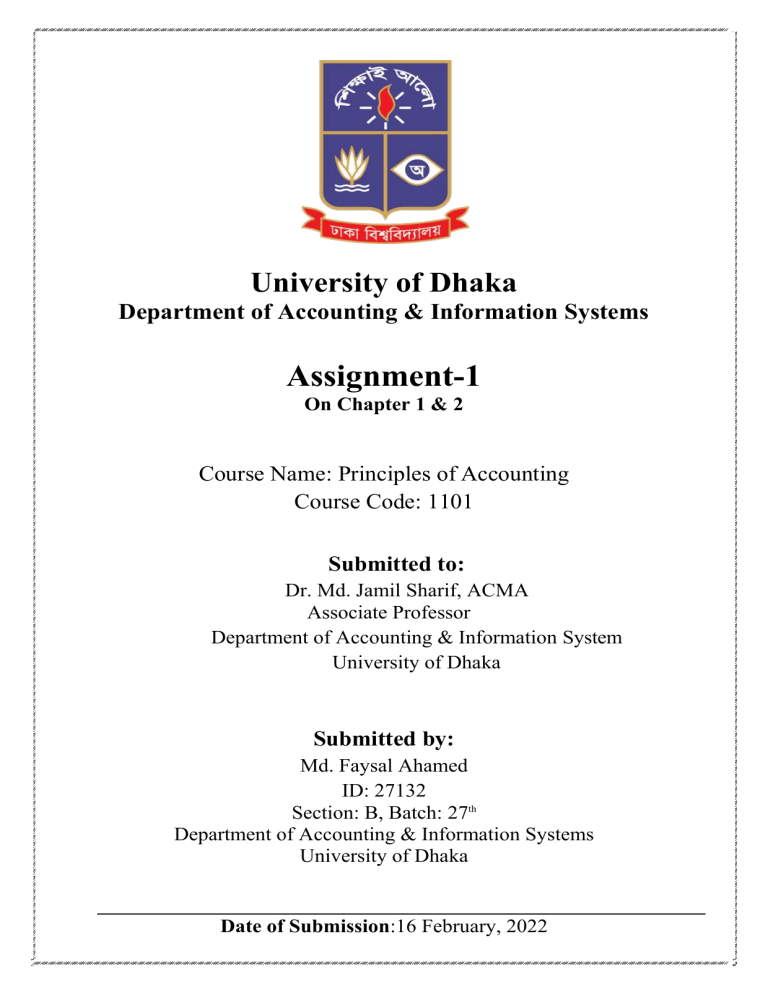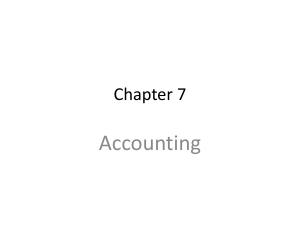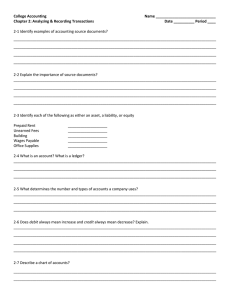
University of Dhaka Department of Accounting & Information Systems Assignment-1 On Chapter 1 & 2 Course Name: Principles of Accounting Course Code: 1101 Submitted to: Dr. Md. Jamil Sharif, ACMA Associate Professor Department of Accounting & Information System University of Dhaka Submitted by: Md. Faysal Ahamed ID: 27132 Section: B, Batch: 27th Department of Accounting & Information Systems University of Dhaka Date of Submission:16 February, 2022 Chapter-1 a) Define Accounting. Why Accounting is called language of Business? Answer: Accountings is an information system that identifies records, classifies, summarizes the economic transactions and communicate the information about the financial position and financial performance of an entity to the interest users so that they can make their financial decisions. Accounting is called the “Language of Business” because it helps people, both internal and external, to understand what is happening inside of business. Just as language is universal to people, so is accounting in business. Accounting helps to analyze the economic events going on in a business or institution; it also creates reports & shares the information to the interested users thus sustaining an economic communication. b) What are the different branches of Accounting? Answer: There are many different branches of accounting. Such as financial accounting, cost accounting, management accounting, auditing & tax accounting, funding accounting, government accounting, forensic accounting, fiduciary accounting. Among those the main three branches are- financial accounting, management accounting & cost accounting. Accounting Financial Accounting Cost Accounting Management Accounting c) “Accounting equation is the basis of double entry accounting”–explain. Answer: Accounting equation refers that the total assets of an institution is equal to the total of liability & owner’s equity. The double-entry system of accounting means that for every business transaction, amounts must be recorded in a minimum of two accounts. Which means every transaction will affect at least two parties or accounts. In case of transactions, both of the criteria are needed to be fulfilled. So, the accounting equation & double entry system are inter-related. Thus, it can be said that “Accounting equation is the basis of double entry accounting”. d) Define financial accounting. Describe the users and purpose of using accounting information. Answer: Financial accounting is a specific branch of accounting involving a process of recording, summarizing, and reporting the myriad of transactions resulting from business operations over a period of time. These transactions are summarized in the preparation of financial statements, including the balance sheet, income statement and cash flow statement, that record the company's operating performance over a specified period. There are two types of users of accounting internal users & external users. In financial accounting, these reports are prepared for the external users. Usually external auditors are hired by the organization for auditing & monitoring financial information. Financial accounting ethics form the basis for legal & regulatory requirements & include issues related to maintaining public trust. Chapter-2 a) Define the accounting cycle. Describe the steps of accounting cycle. Answer: The accounting cycle is a collective process of identifying, analyzing, and recording the accounting events of a company. It is a standard 8-step process that begins when a transaction occurs and ends with its inclusion in the financial statements. b) What is Chart of Accounts? What are the importances of chart of accounts in designing accounting system of any business organization? Answer: A chart of accounts (COA) is an index of all the financial accounts in the general ledger of a company. In short, it is an organizational tool that provides a digestible breakdown of all the financial transactions that a company conducted during a specific accounting period, broken down into subcategories. If a organization records their accounts by name it will has many negative sites, such a it needs more time, more space, more work and so on. That’s why chart of accounts is necessary. Typically, when listing accounts in the chart of accounts, a numbering system is used for easy identification. Numbering also makes it easy to record a transaction. Small businesses commonly use three-digit numbers, while large businesses use four-digit numbers to allow room for additional numbers as the business grows. Groups of numbers are assigned to each of the five main categories, while blank numbers are left at the end to allow for additional accounts to be added in the future. Also, the numbering should be consistent to make it easier for management to roll up information of the company from one period to the next. Example: A large business numbering system➢ Assets: 1000-1999 ➢ Liabilities: 2000-2999 ➢ Shareholder’s equity: 3000-3999 ➢ Revenue: 4000-4999 ➢ Expenses: 5000-5999 c) What is trial Balance? What are the purposes and limitations of Trial Balance? Answer: A trial balance is a statement, prepared with the debit and credit balances of the ledger accounts to test the arithmetical accuracy of the books. Usually it is prepared at the end of the accounting period for testing the mathematical equality of debit-credit after posting. Although trial balance is used to identify the mathematical error, it has some limitations of its own. Some limitation is given bellow:- ❖ ❖ ❖ ❖ ❖ A transaction that is completely missing was not even journalized. When the wrong amount was written in both the accounts. If a posting was done in the wrong account but in the right amount. An entry that was never posted in the ledger altogether. Double posting of entry by mistake. e) Simanto, a beginning accounting student, believes debit balances are favorable and credit balances are unfavorable. Is Simanto correct? Discuss. Answer: Shimanto’s concept is not properly correct. Usually assets & expenses gives debit balance & liability & owner’s equity, revenue gives credit balance. None of debit or credit balance is favorable for the business, it actually depends on the type of account. As an example, let’s say if revenue balance is debit then it indicates that decrease in owner’s equity but suppose the balance is credit then it increases owner’s equity. In the same away, if expense balance is debit then it indicates that the owner’s equity decrease but if it is credit balance then it indicates increase of owner’s equity. Thus we can say that neither debit balance nor credit balance is favorable for an organization. Rather it depends on the nature of the account.




